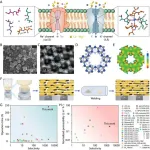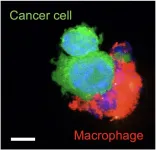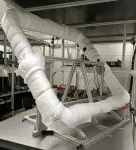(MEMPHIS, Tenn. – June 14, 2024) Scientists at St. Jude Children’s Research Hospital today announced a way to improve molecular scale distance measurements using single-molecule fluorescence resonance energy transfer (smFRET). smFRET quantifies the excitation and emission properties of chemicals called fluorophores.
When an excited electron in the fluorophore relaxes, it emits light after a delay, causing the molecule to glow (fluoresce). However, fluorophores don’t always fluoresce after excitation. Instead, through quantum mechanical processes related to the excited electron’s “spin” state, they can enter long-lived triplet dark states that do not fluoresce. This reduces the sensitivity and accuracy of smFRET measurements. By controlling the duration of dark states through “self-healing” technologies, St. Jude scientists now show that triplet dark states can be strongly mitigated. This advance significantly increases the method’s resolution to advance the field of molecular imaging. The findings were published today in Nature Methods.
smFRET captures fleeting molecular moments
Capturing the flap of a hummingbird’s wings requires specialized cameras with a high frame rate and lighting that avoids the blur of fast motion. Visualizing a hummingbird’s flight pales in comparison to the challenges of capturing the functions of biomolecules in our body. Biomolecules are smaller than the wavelength of light (on the order of one billionth of an inch), and their functions are tied to their motion, changing positions or shape (conformation) hundreds to thousands of times per second. Measuring these fleeting dynamics is vital to truly understand how molecules perform their functions, how these functions are perturbed in disease and how drug therapies modify their activities. smFRET, a molecular imaging technique, is a powerful way to directly visualize how biomolecules move in real-time and at the single-molecule scale.
At St. Jude, Scott Blanchard, PhD, Departments of Structural Biology and Chemical Biology & Therapeutics, is advancing the field of smFRET imaging. Efforts in the Blanchard lab, through the St. Jude Single-Molecule Imaging Center, have been critical to the design and development of fluorophores that enable measurements on the molecular scale.
“The most common and widely employed fluorescent molecules are generally not up to the task of quantifying events at the molecular scale. This led us to take on the challenge of synthesizing our own fluorophores,” Blanchard said. “In the process of doing so, we realized that the fundamental photophysics of fluorescence needed to be altered.”
To conduct smFRET experiments, researchers place fluorophores on two points of a biomolecule. When a laser is directed at the first of these fluorophores (the donor), an electron within it gains that energy, becoming excited. When the electron relaxes, this energy is transferred through space to the second fluorophore (the acceptor), but only if it is close to the donor. By recording and quantifying fluorescent bursts from both donor and acceptor fluorophores, distances can be measured on the order of one billionth of an inch. Each piece of information is vital to understanding biological function and malfunction. However, correct use of the technique requires careful navigation of the fundamental properties of fluorescence.
Electron spin flip locks in triplet state
The rules governing a fluorophore’s emission of light revolve around electron spin. When an excited electron relaxes, it should go back to its original state, maintaining its spin state or spin quantum number. This does not always happen, however.
“Every time an electron is excited, there’s a probability that it will lose memory of its spin and adopt an inverted spin state,” said Blanchard, corresponding author of the Nature Methods study. “While this process is relatively rare, with an approximate 1 in 100 probability, if it does change its spin state, then it ends up in this 100,000 times longer-lived triplet state that does not fluoresce. Consequently, the fluorophore becomes much dimmer than it otherwise could be.
“The field of fluorescence has been struggling with this for years,” Blanchard added. “In the context of FRET, we’ve noticed that triplet state accumulations change with illumination intensity and vary for different fluorophores.”
FRET requires the donor and the acceptor fluorophores to behave the same way. But, because the technique requires exciting one directly and not the other, when you turn up the laser, the triplet states of the donor and the acceptor become occupied at different rates.
“You end up with a sea-sickening process where the donor and the acceptor plateau at different levels, so they’re losing performance at different extents,” explained Blanchard. “Experimental readouts become varied, leading to reductions in the quality and reliability of the imaging data. This fundamentally restricts both the spatial and temporal resolution limits of smFRET measurements.”
A key goal of fluorophore engineering studies is, therefore, to reduce the lifetime of triplet states to the extent that is possible. This is the foundational goal of ‘self-healing’ technologies.
“To ensure accurate distance measurements in smFRET data, the field currently relies on calibration steps that do not explicitly consider triplet states,” explained co-first author Zeliha Kilic, PhD, St. Jude Department of Structural Biology. “Self-healing technologies move the field closer to optimal conditions where triplet states are absent, ensuring that the calibration steps employed yield more accurate results and thus distance measurements.”
Self-healing fluorophores guide the way
Chemicals called triplet state quenchers, such as cyclooctatetraene, counteract this phenomenon but also tend to gum up the works. “Cyclooctatetraene is greasy, exhibits varied and low solubilities, and is challenging to control,” said Blanchard.
Previous publications from Blanchard’s team reported the development of fluorophores with cyclooctatetraene directly attached. This approach solved the solubility issue and created “self-healing” fluorophores in which triplet state occupation was reduced by up to 1000-fold. In the new study, the researchers demonstrated that using self-healing fluorophores as donors and acceptors in smFRET experiments improves data quality and reliability and prevents loss in imaging quality as laser intensity increases. These improvements push forward the frontiers of smFRET, and self-healing fluorophore technologies are finding increasingly diverse applications worldwide.
“The enhanced brightness and photostability of self-healing fluorophores make it possible to improve the spatiotemporal resolution of smFRET imaging dramatically,” said co-first author Avik Pati, PhD, formerly of St. Jude Department of Structural Biology, now of Birla Institute of Technology and Science. “We can now robustly quantify nanometer-scale conformational dynamics within single biomolecules at sub-milliseconds and at physiological oxygen concentrations.”
Blanchard is confident these findings will help St. Jude researchers and the broader scientific community. “Pushing the frontiers of imaging innovations at St. Jude is part of the institution’s strategic plan, and we are confident that self-healing fluorophores will play an important role in meeting our goals,” he said. “Moreover, many are likely to benefit from these advancements as the self-healing approach has shown potential to improve most fluorescence applications.”
Authors and funding
The study’s other authors are Daniel Terry, Alessandro Borgia, Sukanta Bar, Roman Kiselev, and Roger Altman of St. Jude, and Steffen Jockusch of Bowling Green State University.
The study was supported by grants from the National Institutes of Health (R01GM098859) and ALSAC, the fundraising and awareness organization of St. Jude.
St. Jude Media Relations Contacts
Chelsea Bryant
Desk: (901) 595-0564
Cell: (256) 244-2048
chelsea.bryant@stjude.org
media@stjude.org
Rae Lyn Hartley
Desk: (901) 595-4419
Cell: (901) 686-2597
raelyn.rushing@stjude.org
media@stjude.org
St. Jude Children’s Research Hospital
St. Jude Children’s Research Hospital is leading the way the world understands, treats and cures childhood cancer, sickle cell disease and other life-threatening disorders. It is the only National Cancer Institute-designated Comprehensive Cancer Center devoted solely to children. Treatments developed at St. Jude have helped push the overall childhood cancer survival rate from 20% to 80% since the hospital opened more than 60 years ago. St. Jude shares the breakthroughs it makes to help doctors and researchers at local hospitals and cancer centers around the world improve the quality of treatment and care for even more children. To learn more, visit stjude.org, read Progress: A Digital Magazine and follow St. Jude on social media at @stjuderesearch.
END





